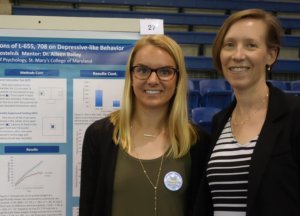
Claire Kostelnik with Dr. Bailey at the SMP Poster Session at the Michael P. O’Brien ARC on May 2, 2017.
Claire Kostelnik ’17 received a Psi Chi Undergraduate Research Grant. $112,500 is distributed annually by the grant program in support of undergraduate research; Claire’s grant was $1,500 of that pool. Her SMP study “Intraventricular Injections of L655, 708 on Depressive-like Behavior,” is being mentored by Dr. Aileen Bailey. Congratulations, Claire and Dr. Bailey!
Claire’s project abstract:
Depression is a leading cause of mortality and morbidity worldwide. The standard therapeutic care for depression is Selective Serotonin Reuptake Inhibitors (SSRIs), which present a 3-8 week delay before displaying any effect and are additionally only effective in about half of patients (Gaynes et al., 2009). With similar properties to the drug ketamine, partial inverse agonists of GABA receptors containing alpha-5 subunits (e.g., L-655, 708) may treat a wider range of patients without this delay. Previous findings have found a rapid antidepressant action on the social interaction test and sucrose preference test following L-655, 708 (0.7 mg/kg) injected intraperitoneally in chronically stressed rats. The proposed study aims to display the rapid antidepressant actions of L-665, 708 infused intraventricularly in a chronic unpredictable stress model of depression in rats. Cannula surgeries will be performed and rats will receive an infusion of L-655, 708 (2nmol in 2 μL at .25 μL/ min) or a vehicle into the lateral ventricles. Antidepressant effects will be measured using the sucrose preference test, social interaction test, and novelty suppressed feeding test.
Zoey Forrester-Fronstin ’17 also won a Psi Chi Undergraduate Research Grant in the amount of $1,500 for her SMP study, “The Influence of Orexin Antagonist, SB-334867, on Cognition.” Her proposal fell in the top 8 of applications overall and so it also received a faculty stipend of $1,500 for her mentor, Dr. Aileen Bailey, in addition to the grant. Congratulations, Zoey and Dr. Bailey!
Zoey’s project abstract:
The effect of orexin A (OxA) on acetylcholine (ACh) activity by way of the orexin-1 receptor (Ox1) is a studied pathway in the pathology of Alzheimer’s Disease (AD) (Boschen, Fadel, & Burk, 2009; Fadel, Pasumarthi, & Reznikov, 2005). The change in efflux of ACh is seen to contribute to the cognitive impairments and molecular changes (e.g. tau phosphorylation) evident of AD (Blennow, de Leon, & Zetterberg, 2006). OxA released via the lateral hypothalamus projects to the nucleus basalis magnocellularis of the basal forebrain, which in turn activates Ox1 receptors naturally (Scammell & Winrow, 2011). Recent literature has indicated that the compound SB-334867 selectively antagonizes Ox1 (Smart & Jerman, 2002). Blocking Ox1 is known to decrease ACh release in the cortex and alter domain specific cognitive flexibility (Fadel & Burk, 2010){Fadel, 2010 #30}{Fadel, 2010 #30}. The proposed study aims to identify deficits in a more general form of behavioral flexibility, the set-shifting task. A set-shifting task measures the ability for an animal to learn a “correct” rule, have the “correct” rule change, and learn the new rule. This set-shifting ability has been found to be disrupted in AD patients. It is hypothesized that following an infusion of the OxA antagonist, SB-334867, into the nucleus basalis magnocellularis—the ability for rats to shift from the original rule to a new rule will be impaired.

